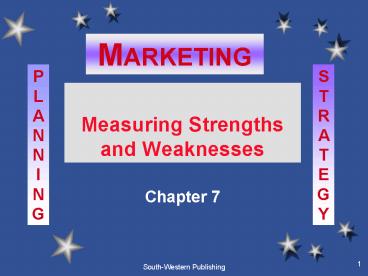Measuring Strengths and Weaknesses - PowerPoint PPT Presentation
1 / 28
Title:
Measuring Strengths and Weaknesses
Description:
Underlying reasons for firm's success. Characteristics and traits. South-Western Publishing ... of reporting in firm's structure. South-Western Publishing. 28 ... – PowerPoint PPT presentation
Number of Views:55
Avg rating:3.0/5.0
Title: Measuring Strengths and Weaknesses
1
Measuring Strengths and Weaknesses
- Chapter 7
2
Topics Chapter 7
- Measuring Strengths and Weaknesses
- Product
- Current Strategy Posture
- Past Performance
- Marketing Environment
- Opportunity Analysis
3
Strengths
- Competitive advantages
- Distinctive competencies
- What firm does well
4
Weaknesses
- Constraints
- Hindrances to movements in certain directions
5
Measurement of Product Strengths and Weaknesses
Competition
Product/Market Review Current Strategic Posture
Product/Market Review Past Performance
Strengths and Weaknesses
Marketing Effectiveness
Marketing Environment
6
Current Strategic Posture
- Underlying reasons for firms success
- Characteristics and traits
7
Current Strategic Posture
- Critical factors affecting strategy
- Extent and direction of likely changes in
critical factors
8
Measuring Strategic Posture
- Current scope of firms activities
- Pattern of past and existing resource deployment
9
Measuring Strategic Posture
- Basis on which firm competes
- Performance criteria, emphasis, and priorities
10
Current Strategy of Product/Market
- What markets do we have?
- How is each market served?
11
What Market Do We Have?
- Market segments
- Demographic profile of each segment
- Important customers
- Customers doing business with competitors
- Reasons customers buy
12
What Market Do We Have?
- Strategic perspective of important customers as
it concerns the products purchase - Anticipated changes in customers perspectives
13
How Is Each Market Served?
- Means used to serve different customers
- Analyze information such as
- Definitions of markets
- Buyer behavior
- Product reputation
14
How Is Each Market Served?
- Resource base
- Channel relationships
- Pricing strategies
- Promotional strategies
15
Measuring Past Performance
- Identify trends of
- Consumer volume of segments
- Product brand preferences
- Shipment total units and by brand
- Spending per unit marketing costs
16
Measuring Past Performance
- Identify trends of
- Profit price, margin, profit
- Market Share scope, brand, distribution channel
- Total market
- Competitive brand
17
Performance Measures
- Growth rate
- Profitability Market Share
- Cash flow
18
Performance Standards
- Company performance
- Competitor performance
- Management expectations
- Performance in terms of resources committed
19
Marketing Environment Constituents
- Social and cultural effects
- Political influences
- Legal requirements
- Competition
20
Marketing Environment Constituents
- Technological changes
- Institutional evolution
- Consumerism
- Population
21
Marketing Environment Constituents
- Location of consumers
- Income
- Expenditure patterns
- Education
22
Areas of Strength Examples
- Excellent product design
- Leader in product innovation
- Efficient customer service
- Effective sales promotion
23
Areas of Strength Examples
- Merchandising efficiency
- Customer loyalty
- Dominant market share
- Advertising effectiveness
24
Opportunities Analysis
- Matching strengths or competencies to
opportunities - Input to corporate economic mission
- Individual product objectives
25
Opportunities Analysis
- Analyze impact of environment
- Opportunities develop in environment
26
Format for Opportunities Analysis
27
Marketing Weaknesses
- Inadequate definition of customer for
product/market development - Ambiguous service policies
- Too many levels of reporting in firms structure
28
Marketing Weaknesses
- Overlapping channels
- Lack of top-management involvement in new product
development - Lack of quantitative goals































